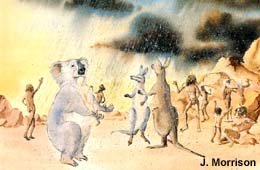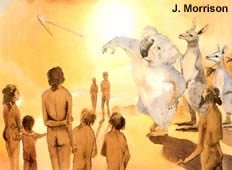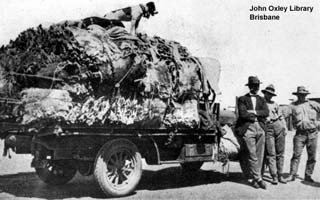Koalas or Koala-like animals probably first evolved on the Australian continent during the period when Australia began to drift slowly northward, gradually separating from the Antarctic land mass some 45 million years ago. Fossil remains of Koala-like animals have been found dating back to 25 million years ago.
As the climate changed and Australia became drier, vegetation evolved to what we know as eucalyptus, becoming the Koalas food source.
Australia’s Indigenous people are thought to have arrived in Australia 60,000 years ago or more. Koalas, like all Australian animals, were an important part of Aboriginal culture and feature in many of their myths and legends.
Koalas were a readily available source of food, but they remained abundant over their range before the arrival of Europeans with the First Fleet in 1788.


Illustrations by J. Morrison, from Bill Phillips: ‘The little Australians we’d all hate to lose’
John Price was the first European to record Koalas. He described them in his account of a journey into the Blue Mountains near Sydney in 1798. The Koala was given its scientific name, phascolarctos cinereus, meaning ‘ash grey pouched bear’ in 1816. Subsequently, it was discovered that the Koala was not a bear at all, but a member of a specialised group of mammals called ‘marsupials’, that give birth to immature young and carry them in a pouch. Today, most marsupials are found in Australia and Papua New Guinea.
‘Koala’ is thought to mean ‘no drink’ in the Aboriginal language, although there are many different languages spoken by Aboriginal people throughout the country. The name for Koala appears in diverse forms in the written accounts of early settlers as cullewine, koolewong, colo, colah, koolah, kaola, Koala, karbor, boorabee, and goribun.
As the new colony progressed, the clearing of forests for farmland began, and with it the beginning of the loss of habitat to the native animals. European settlers identified the Koala as a source of fur to trade, and in the ensuing years up until the 1930’s, millions of Koalas were shot for their pelts.


From Bill Phillips: ‘The little Australians we’d all hate to lose’
By 1924 Koalas were extinct in South Australia, severely depleted in New South Wales, and estimates for Victoria were as low as 500 animals. At this time, the focus of the fur trade moved north to Queensland. In 1919 the Qld Government announced a six month open season on Koalas, and in that period alone, 1 million Koalas were killed. Although the season officially remained closed until 1927, when the season re-opened, over 800,000 were slaughtered in just over 1 month. Public outrage at the slaughter forced governments in all states to declare the Koala a ‘Protected Species’ by the late 1930’s. However, no such laws were brought in to protect the gum trees upon which Koalas rely for their food and shelter. This remains the case throughout the Koala’s range.

